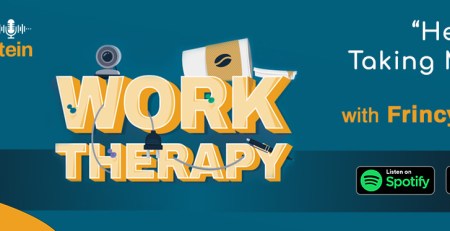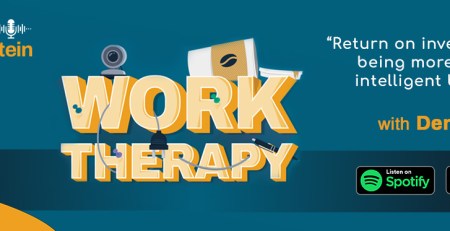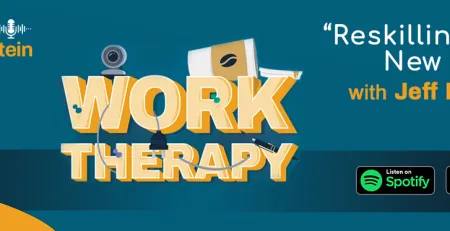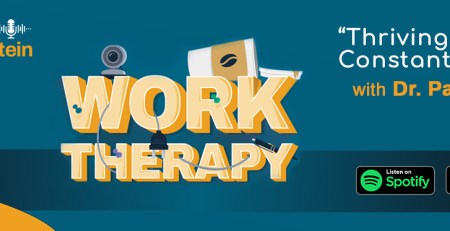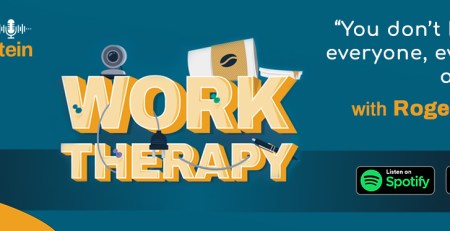Work Therapy: How can we solve the burnout epidemic?
In this week’s episode of Work Therapy with Dr. Steven Stein, we chat with Dr. Michael P. Leiter, an organizational psychologist interested in people’s relationships with their work. Dr. Leiter has published widely on job burnout, work engagement, and workplace civility.
We discuss what really causes burnout (spoiler: it’s not just having too much on your plate) and how to avoid it.
DR. STEIN: Friday, Saturday, Sunday. Oh, no. Does the idea of going back to work on Monday morning strike fear in your heart? Sometimes work gets so exhausting. Even a long weekend doesn’t feel long enough. When you have too much to do, you can’t wrap your head around the tasks at hand. You’re dreading having to meet with your coworkers. The sound of an incoming email makes you want to cry, and we all know what’s going on here. Basically, you’re burnt out, but burnout can be avoidable. Well, if not avoidable, at least you can manage it better.
DR. STEIN: I’m Dr. Steven Stein. I’m a clinical psychologist and founder of MHS, a leading developer of innovative scientific assessments in the talent development space and beyond. I’m here to tell you that work sucks sometimes. It does, I can admit it, but it doesn’t have to. In work therapy, we speak with experts from diverse backgrounds helping us wade through some of the most common issues people have on the job. We learn how to go beyond just surviving at work and learn how to start thriving, because if work sucks, how can we fix it?
DR. STEIN: Hey, Michael, it’s great to meet you and thank you for coming along and doing this podcast with us.
MICHAEL: Good to meet you too, Steve. I really appreciate having the opportunity to talk to you about all these important issues.
DR. STEIN: Well, today we’re talking about the burnout epidemic, and it seems to be something that you know a lot about. Why don’t you start off by telling us how you got involved in that? What got you engaged with this topic? Was it a specific work experience or a story you heard or… How did you get involved in burnout?
MICHAEL: Well, a long time ago I was doing some work with a residential mental health facility, and one of the issues there was a lot of tension between psychiatry and psychology within this particular organization, which I gather was not unique to this one institution. But, as I was working with them, you could see that it was really taking a toll on people. It was sort of built into the fabric of the place and people, like a particular one psychologist, who was a very experienced and adept clinical psychologist, and he decided to leave all of that to go open a bed and breakfast in Lunenburg, Nova Scotia rather than continue on with this profession.
MICHAEL: I thought it was very striking to have put so much into preparing for this career, which has a real impact on people, it could be very, very rewarding, but to get to a point because of the way the work was structured, that he wanted out of there.
MICHAEL: In the midst of that time, I came upon the first article written by Christina Maslach and Susan Jackson on job burnout that they wrote in a Journal of Organizational Behavior. I said, “Oh, this is what’s going on here.” I had a sabbatical coming up from my university here in Nova Scotia, Acadia. I just phoned Christina out of the blue and she answered the phone.
MICHAEL: I said, “I’d like to come out and work with you for this year.” She said, “Oh, fine. I’ve got an office for you. Let’s work on burnout.” I went out and we worked together that year. We wrote our first article together on co-worker and supervisor relationships and their relationship to burnout. That was our first article together, in the 1980s, and we’ve been writing together ever since.
DR. STEIN: That’s very impressive. I mean, Christina Maslach is considered one of the originators of the whole concept of burnout, so what a lucky opportunity for you to get to spend that time working with her. Your new book is called The Burnout Challenge. How did that book come about? You’re working on that with Christina.
MICHAEL: Right. We had been working together a lot. We wrote our… I guess our first book that got a lot of traction in the 1990s was The Truth About Burnout. The 90s are 25 years ago now and so we thought, one, there’s a lot that’s happened in the meanwhile, and also, we’re at a point in our career where it’s time to write something that pulls together the wisdom of all of that work together, those thoughts over the years. Then, we connected with people at Harvard University Press, and they thought, “Well, that was an opportune time for such a book.” That became our pandemic writing project and the pandemic brought burnout much more into the focus of the larger world.
DR. STEIN: No better timing for that than during the pandemic. We’re seeing burnout practically everywhere we look. The name of this show is called Work Therapy: When Work Sucks, How Can We Fix It? Let me ask you, why does work suck so much and what can we do to prevent people from getting burnout?
MICHAEL: I think sort of a fundamental kind of intrinsic problem is that workplaces are designed largely, well, to produce what the people in charge of the workplaces want it to produce. They’re not primarily thinking about people, their psychological needs, their core motivations, the aspirations that people are bringing to work. They’re not thinking about that so much.
MICHAEL: They’re thinking about other kinds of ideas that they think of in terms of productivity. There is this mismatch that happens between people and work, and people are looking for a lot from their workplaces these days. Each generation that comes through is looking for a higher standard of concern, of responsiveness, of value realization. The workplaces are behind the pace. There’s some are scrambling to try to keep it on the edge of that wave, but… They’re not quite there yet.
MICHAEL: There’s still a lot more work to do and a lot more flexibility because to really engage people and for the level of performance and thinking and integrity that really, you need from people and workplaces these days, the workplaces have to deliver more. They have to resonate more with what people are all about and they’re missing it a lot.
DR. STEIN: What are some specific things you think they can do? How can they pay more attention to people, help them along this journey?
MICHAEL: Well, I look at sort of core motives in terms of belonging and efficacy and autonomy. The ones… They get a lot of coverage and psychology, but what is that issue of belonging? That people want to be part of a community. They don’t want to just be tolerated as part of the community, they want to be confirmed as valued members of that community and work is one of those places where it really matters because work is where you can have an impact beyond yourself.
MICHAEL: It’s where you can realize, really, the higher end of your talents and abilities. It really matters as an arena. Being accepted, belonging, being respected as a member of that community is very important. Some people get that, a lot of people are not getting that when you’re going to work, they’re getting something quite different.
MICHAEL: Secondly, that sense of efficacy, to be confirmed that you’re good at something, what you’re doing is important, it’s making a contribution. That’s a thing, which again, a lot of places are neglectful on confirming people in that way and they spend time doing things that are of no particular, obvious value to anybody.
MICHAEL: Wasting people’s time at work is a very expensive thing for workplaces to do. That issue of autonomy, people want to be not always on the receiving end of other people’s agenda. They want to have that opportunity to make something happen and to know, “I contributed that. I had some initiative.” A lot of workplaces are too much into control to really allow that to happen.
DR. STEIN: So, we have someone, let’s say, listening to this podcast who doesn’t feel they’re in control in terms of what they’re doing in their job, they don’t feel really accepted by the workplace. What can they do? How can they start to change things?
MICHAEL: Yeah. It’s very hard as an individual to start to change things. You have to figure out, what leverage do you have? I advise people to take some time. If that’s your situation, things aren’t going to change fast so you can take some time and you can start tracking of your workdays. When were there times that really were fulfilling for you in these workdays? What were some times that were really at the tedious end of things in your workdays? Track that for a while.
MICHAEL: Your first little strategy can be, what can I do to just nudge things towards doing more of the things that I like here and doing less of the things that I really dislike in this particular job? Even if you’re working on a larger organizational intervention, you’re always looking at nudging things a little bit in the right directions.
MICHAEL: Drastic changes within workplaces don’t go over very well with people so you got to take your ambitions down, you got to patient and got to think, how can I keep nudging this in the right direction? What can really help is, can you identify some colleagues, some friends who can work with me on this, that we can do this as a group effort? I’m not just dumping the bad work on other people; we’re figuring out ways of circumventing it and making things happen.
MICHAEL: I think an important thing for people to realize about work, is that workplaces aren’t really all that kind. They’re not going to look after you all that well. You’ve really got to look after yourself. You got to go into these things with the idea you’re taking on an environment that you’re not really top of their mind at any given time. You’re part of this, like it’s a relationship problem. What leads to burnout? These mismatches are really between people and their workplaces. You can’t solve it all by yourself, but the workplace can’t solve it all by itself either. It is this thing where you’ve got to get a dynamic going and to the extent you can talk to your supervisor, leadership about these issues, that’s a very powerful kind of thing.
DR. STEIN: Well, let’s say you’re consulting to an organization and they’re going through a process where, let’s say, they’re losing a lot of people due to burnout, quiet quitting, all these things we hear about. They’re going through a difficult time, and they come to you. What are some of the things you would suggest for an organization in order to reduce the amount of burnout that they’re experiencing?
MICHAEL: Well, I like the data. I’ve always started… I have always been a researcher, and so I do like, you’re working on doing a survey that gets the points of view of people within that organization. There’s not going to be a universal problem that’s leading to burnout. There’s going to be a lot of distinct pieces for individuals, for work groups, for professional groups within there and you’ve got to figure out how that’s mapping.
MICHAEL: A lot of places don’t make very good use… They do surveys without making good use of them. They don’t have their communication strategy worked out beforehand. They don’t know how to really plumb the depths of the data they have to really keep that conversation going with people. I help them with the analysis, I help them with reading the comments that people make and there I try to figure out, what is it?
MICHAEL: It’s conversation we have to get into now. It’s a collaborative process of dealing with burnout in a workplace. In terms of content, we look at these six areas of work life of workload, control, reward, community, fairness and values. We look at the data and we have a measure for that. Where’s the biggest mismatches for this group? What are their issues that they’re finding is really a problem?
MICHAEL: One thing I’ve worked with a lot is on community, that people have socially toxic workplaces. Then we work on them on doing a workplace intervention, on improving civility, improving respect, improving the quality of communication among people within the group. You’re just saying, “Here’s where the mismatch is. Here are people’s ideas about what they would like to see changed, and let’s start working together with leadership to see what we can bring about there.”
MICHAEL: We’re asking questions like that, really nitty-gritty stuff and seeing that’s the needle we want to change. Because we’ve shown that if you change those kinds of things, it has an impact on the exhaustion, the cynicism. They tend to abate when you change those kinds of social dynamics.
DR. STEIN: All right. You have an organization. Is there an example of where you’ve applied some of these principles in an organization and you’ve seen actual change? What kind of changes have you seen as a result of these interventions?
MICHAEL: We did a number of studies with this kind of intervention in Canada a number of years ago. We did show that, one, you can change the level of civility, people are responding before and after that the level of positive stuff is more frequent, the level of negative stuff has gone down and contrast it with control groups that showed no change like that during that time.
MICHAEL: We demonstrated that, and it also demonstrated that downstream, that exhaustion and cynicism within burnout, those aspects of burnout have diminished during that time as a function of these. It improved as a function of better social dynamics.
MICHAEL: People want to get along. They get stuck and they can’t get out of it. They get stuck in places where they’re not getting along. If you give them a road out of that, some kind of psychological safety framework that lets them get out of it, they’ll go along with it and they’ll work to sustain that. What you find actually is some people will leave. They don’t like that change in the social dynamics. You’ll lose some people along the way because things… They don’t want to be nice to each other and you have to swallow that loss.
DR. STEIN: Let’s get back to the individual contributor. You got someone who’s working at whatever it is they’re doing their job, they’re on the front line, they’re overworked, they’re burning out, they’re exhausted. How far can self-help get you and when do you need something beyond that?
MICHAEL: The healthier, the stronger, the more confident you are, you’re going to be able to thrive in a wider variety of situations, but there’s a limit to how far that can go. One, you’re going to get so strong and then things start having an impact. Secondly, there are just things that you shouldn’t put up with. That’s the other part of it. That’s where, when we look at the rude behavior at work, like being disrespected at work, it’s not something, really, you’re supposed to just get used to. It’s a problem if you’re getting used to that and saying, “Well, that’s okay, people give it…” No, actually it’s not okay. It’s something that really needs some intervention.
MICHAEL: You got to figure out how tough can you get on this, in terms of workload. What really bothers people about workload is it’s not the productive work that does things that you really value. That’s not usually what’s burning people out. It’s much more often the work that seems like a waste of time like, it’s imposed upon me – it’s poorly organized so it’s infringing into my personal life. Those are the kinds of things that, it’s not just the amount of work, it’s much more the character of the work that really aggravates that exhaustion and whatnot.
MICHAEL: There’s a certain amount you can expand what you can carry in terms of workload, but if you’re not being compensated for carrying more and more beyond the regular structure of a workday, then that’s also something you should reflect on. Why am I building myself up in order to be essentially overused by a workplace that’s not fully resourcing what needs to be here? A lot of time what we see, people who are sort of self-identifying or being identified as burning out, they’re not really having that full experience of being exhausted and cynical and discouraged.
MICHAEL: A lot of them are just exhausted. They really believe in what they’re doing. They really think it’s important work. They really think they’re doing it well. They have confidence. They’ve got efficacy, they’ve got involvement and just tired because the place is under resourced.
MICHAEL: It can work awhile if you’re in an extreme emergency situation and you’re the only one and you’ve got to… But it’s not a way to structure a work-life going forward. You’re going to give out eventually. But, that first stage of just being exhausted all the time, that’s a much more straightforward problem. You can start restructuring the work, get people better opportunities for recovery, for resting, for sleeping, for all of that, but that’s really different from the full burnout, which is that exhaustion on top of cynicism and hating the job and really being discouraged.
DR. STEIN: I’m wondering… I’m seeing a lot more of this exhaustion, I guess, post-pandemic and maybe affected by the pandemic. What’s been your experience? You’ve been working in this for quite some time before the pandemic, I’m sure during, and now. What effect are you seeing on the pandemic on burnout?
MICHAEL: It’s a mixed effect. I think that for… There is certainly a slice of the world where, particularly, exhaustion is much more prevalent. I see it in data that that’s crept up. It’s not drastically, but it’s definitely at a higher level and it was already too high before. That’s certainly there. Part of it is that the issue of change, just changing how you’re working is an extra burden. It takes more energy; it takes more focus in order to adapt to change.
MICHAEL: The transition into sort of pandemic mode was a burden in itself. That was during the pandemic, particularly the early part before there were vaccines. It was scary. It was frightening not to have any contact with people and isolating. Over time, I think what’s happening with people who, while they were working from home, what you find is a lot of people want to continue working from home.
MICHAEL: It was a transition. It was a little hard at the beginning, but actually, it’s not so bad. It also showed that things can change because people, their experience was they were just as productive, if not more so, working from home as they were going into that office.
MICHAEL: There’s a skepticism now against what management’s saying, “Well, you have to come in to be productive.” You go, “Well, no. I don’t actually.” There’s a credibility gap there. Management’s, rather just saying, “You must come in” has to do a lot more thinking and communicating about, well, what are we going to get?
MICHAEL: There’s a credibility gap there. I mean, one, it’s demonstrated that the work world can change a lot, and that’s reduced people’s tolerance for things continuing in a way that doesn’t work for them. I think that is aggravating. When you look at the quiet quitting kind of thing and people just withdrawing from work, actual quitting, a lot of it comes from that, that just sort of, “Wait a minute, we are not working together on this thing right now.”
DR. STEIN: Wow. This whole idea of working from home, which we’re seeing expanding everywhere, do you see that having any influence or effect on the burnout? Does it reduce the burnout? Does it increase the burnout because of the loneliness, isolation? How do you see it fitting in?
MICHAEL: It’s a mixed bag for people. I think that isolation is definitely a part of what can be happening. The other is, again, managers, leaders have to get a lot better at managing the communications. The Zoom calls and Teams calls, whatever medium they’re using, that a lot of that gets just overused. Managers have to be real careful not to waste people’s time, so they’ve got to figure out how that’s all going.
MICHAEL: I think it produces other challenges. It’s going to bring benefits to people who, by saving times on commuting, by saving times on the aggravation of uncivil workplaces, and the other kinds of unpleasant things can happen among people in a workplace. It’s going to be a positive on that side, but it’s very uneven.
MICHAEL: What kind of house do you have? Do you actually have a place where you can set up your office at home, or are you on the kitchen table with the kids all around your feet, or what exactly is the situation here? Really varies a lot. What’s needed are ways of assessing what is your situation, what kind of resources can the employer provide if you’re going to be working remotely that way and see if you can get some progress.
DR. STEIN: Okay. We have a lot of leaders who listen to this podcast. What could you tell a leader who really cares about the people in their organization? They really want to do something, just don’t know where to start. What are three things you would tell them?
MICHAEL: I guess communication is one of them. You really need to find out… Getting a beat on what really is on people’s minds and if they’re not freely telling you, is there a survey format that you can use? Is there some other kind of format you can use in order to get that message indirectly, if not directly, to you, on what the strains are that people are experiencing, what kinds of parts of their work-life are really matching and gelling well for them and what parts are really being mismatched at this point, so that you’ve got a good beat on what’s going on.
MICHAEL: The other is flexibility to the extent to which you can respond to an individual’s strain and change a policy, change something about how many days they’re coming to work, or who they’re working with or anything about their particular work structure. If you’ve got some flexibility to exercise it in that way so that people can have different solutions to what’s going on.
MICHAEL: For managers, that often means for them, negotiating upward in order to get the authority, the prerogative, to exercise flexibility. A lot of leaders are stuck with very rigid policies within their organization and one of their first jobs in order to really be more responsive to their people, is negotiate up the line for having the capacity to be responsive, and to make the case for all of that.
MICHAEL: The metaphor we use in the book is the canary and the coal mine, that some people showing signs of burnout are just, they’re a signal that things aren’t really working for people here and your job is to start changing things. Your job as a leader is to change things, not just change things, but to change things in response to what’s being signaled by your people about what needs to happen here.
DR. STEIN: It’s great, Michael. Thanks very much. Really enjoyed this and you’ve provided us with some great information.
MICHAEL: Oh, thank you. I’ve really enjoyed the conversation.
DR. STEIN: That’s the end of our episode. After hearing from Michael, I can’t help but think about all the ways to map where burnout is coming from in an organization, including paying attention to those canaries in the coal mine. What a great way to reframe how we think about the people in our organization.
DR. STEIN: But of course, I’ve got some actionable tips for you today, too. Tip one is to pinpoint the things you like doing best at your job and think how you can nudge things just a little so that you get to do more of what you enjoy. A good first step could be as simple as letting people on your team know what things you like doing.
DR. STEIN: My second tip is to consider what a healthy workplace boundary looks like for you. This could mean firmly establishing your working hours when joining a new team or a new project, communicating realistic timelines based on your current workload, blocking time to connect with colleagues, or stretch your legs and prioritizing taking time off.
DR. STEIN: You’ll be that much more confident in advocating for your needs if you’ve figured out this ahead of time. My last tip is for leaders. Make sure the people working with you have enough autonomy to feel like the work they do really matters and be ready to support them if they’re experiencing some bumps in the road. I’m Dr. Steven Stein and I look forward to our next episode of Work Therapy. Let’s make work suck less, together.
Have any feedback about this episode or want to learn more about MHS? Reach out to us at [email protected]

